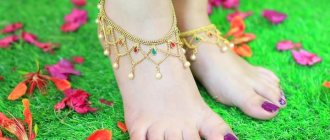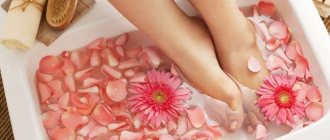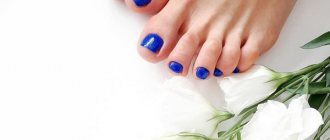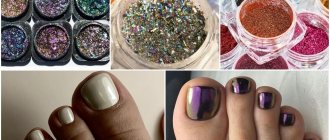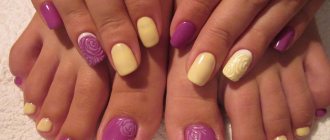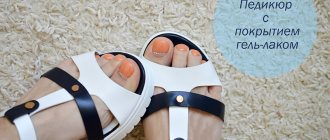You need to take care of your body not only for aesthetics, but also for health. A pedicure will preserve the beauty of your feet and help avoid various diseases. Now this is taught in courses, and pedicurists can be found in all beauty salons. If you still want to learn how to do it yourself, read our article.
In this article we will tell you:
- What is a pedicure?
- How long does a pedicure take?
- Types of pedicure Classic pedicure
- Dry pedicure
- Hardware pedicure
- European pedicure
- Medical pedicure
How much does a pedicure cost?
The price of a pedicure varies from 1,000 to 4,000 rubles depending on the type of service. In addition, the region in which you are located plays an important role. A pedicure will cost you the most in Moscow and St. Petersburg, and in other regions it is a couple of thousand rubles lower.
The most expensive is a medical pedicure, while the European one is cheaper.
If you want to learn how to do a pedicure yourself and not depend on a manicurist's schedule, sign up for a manicure and pedicure course.
During the courses you will be taught how to perform different types of pedicure, as well as how to massage your feet and how to use tools correctly. Classes are suitable for both beginners and those who want to improve their skills and acquire useful skills.
Please note that the courses include not only theory, but also practice. There you will practice your acquired knowledge on models.
On average, the course takes 5 lessons of 3-5 hours and costs from 7,000 to 20,000 rubles.
We hope that pedicure did not seem like a complicated procedure to you. Be patient and experiment. If you still weren’t able to learn on your own, be sure to sign up for a pedicure course and master all types of this procedure.
This training may be right for you:
- Best Online Manicure Courses from 1,000 Rubles
- 10 Best Manicure Training Courses in Moscow
- 10 Best Manicure and Pedicure Courses in St. Petersburg
- Best Nail Extension Courses in Moscow from 1,000 Rubles
- 10 Pedicure Training Courses in St. Petersburg
- 10 Best Nail Extension Courses in St. Petersburg
Choose the Best Courses in Your City: Yekaterinburg , Krasnodar , Nizhny Novgorod , Novosibirsk , Rostov-on-Don , Perm , Krasnoyarsk , Voronezh , Omsk .
Original ideas
In addition to the classics, which never go out of fashion, there are unusual nail design options. One of the most common is highlighting one nail with a pattern, rhinestones or a contrasting color .
No less popular are marine themes (stripes, figures, fish silhouettes, etc.)

Floral designs have long won a huge female audience. Moreover, such designs can be on one nail or on all.
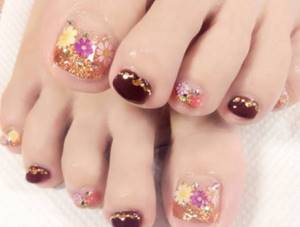
Beautiful summer pedicure
In the summer, closed shoes and boots are replaced by sandals and slates, so getting a beautiful pedicure is the task of every girl. Bright colors, neon varnishes and unusual design elements, voluminous flowers or beads are best suited for this .
How to store
Even medical steel will quickly lose its ground if handled inappropriately. Do you want your “basic beginner’s kit” to last as long as possible? Always follow a few simple rules.
- You should store your little helpers in a case specially designed for this purpose. Moreover , each of them must be assigned its own compartment , otherwise the scissors and wire cutters will become dull or leave scratches on each other’s blades .
- Handle any item from the set with care: do not throw it on the table, do not drop it, do not shake the case.
- Make sure your scissors and wire cutters are sharp.
The use of blunt instruments is strictly prohibited! Tools dumped in disarray are more likely to become unusable - If the blades do become dull, do not try to sharpen them yourself. The cutting surface has a certain angle of inclination, which you can violate with your inept actions. Entrust this task to a specialist.
- Of course, only dry and clean tools should be put into the case.
- Disinfect your pedicure kit regularly.
Does this last requirement seem strange? Indeed, you are not a beauty salon, where the same tweezers bite the cuticles of a dozen or two visitors every day. Perhaps the requirement for sterilization does not apply to household instruments? Let's think about it.
Firstly, your scissors can be used by someone at home at any time - and where is the guarantee that this person did not catch a fungus or something worse a week or two ago, say, in a bathhouse or the same beauty salon? Symptoms of such diseases appear very late, when the disease itself is already in full bloom and smells.
Secondly, if you travel often and carry the set with you, infection can get on it without outside help - for example, from a shelf in the bathroom poorly wiped by a sloppy maid.
Thirdly, on surfaces that are not properly treated, bacteria themselves flourish, which can easily penetrate into a wound accidentally caused during a pedicure. Of course, you won’t get herpes and HIV this way, but you can easily get inflammation.
How to avoid this?
- Tools from a personal set that are constantly stored at home, it is enough to wipe them with an alcohol solution immediately before use and mechanically clean them after work, brushing off the dust of filed nails and other accidental dirt - this is enough to protect yourself.
- If your set has been through fire, water and a cheap hostel, or you have recently suffered from a fungal disease and want to thoroughly clean your tools, you should resort to “deep” disinfection.
In the salon, a sterilizer is used for this purpose - thermal, infrared, ultraviolet. At home, you can use a regular saucepan or oven. The role of a professional device for home sterilization will be taken over by the oven.
First option:
- wash your tools with soap;
- place on a wire rack so that they do not touch and place in an oven preheated to 200°C;
- After a quarter of an hour, the instruments will need to be removed from the oven and allowed to cool completely.
Second option:
- Place the items from the pedicure kit in a saucepan with hot water;
- boil them for 15–20 minutes;
- Carefully remove the water and dry on a towel.
It is worth considering that sterilization using high temperatures can damage poor steel. If you doubt the quality of your instruments, you will have to limit yourself to treating them with an alcohol solution.
Foot hygiene
All keratinization can be removed using files of varying hardness. To keep your legs in good condition between visits to the cosmetologist, you need to follow the following recommendations:
- wash your feet in cool water with soap;
- thoroughly dry your feet and spaces between your toes;
- in case of excessive sweating, use alcohol or special sprays;
- use only special cosmetics;
- Don't forget to nourish your skin, such as moisturizer.
These simple steps will help not only avoid the appearance of dead skin, but also protect against fungus.
Nourish, not nag, and seven more ways to prolong the results of a salon procedure
One of the common mistakes that women make while still in the salon is to ask the specialist to additionally treat the heels with a file or sanding, “so that it lasts for a long time.” This can lead to sad consequences: the skin from which the excess layer has been removed becomes thin and strives to protect itself from damage as soon as possible, that is, to build up new “armor.” Therefore, after excessive processing, a new layer of epidermis will grow even faster and will be even rougher. The masters, of course, know this and do not bring your heels to the “baby-like” state, not out of harm or greed, but because after several such sessions your feet will look worse than before. Finish the pedicure with scrubbing, apply a mask or paraffin - these procedures will help maintain the feeling of soft, smooth legs longer.
How do the characteristics of feet and nails affect the frequency of pedicures?
The frequency of the procedure depends on many features, for example, the intensity of growth of the nail plate, skin type and the degree of its sensitivity. There are cases when the issue of the frequency of professional care and hardware treatment needs to be addressed especially carefully and with caution:
- curved or ingrown nails;
The pathological shape and characteristics of nail growth is a problem that cannot be solved at home. In this situation, even a hardware pedicure and the services of an insufficiently experienced specialist can cause harm. With a similar problem, you need to visit beauty salons at least once every 10-12 days.

Deformation of the nail plate
- presence of cracks or corns;
Rough, problematic skin on the feet definitely needs a hardware pedicure and proper care. If you don't take care of your feet, more serious problems may arise. In this situation, it is enough to carry out the procedure at least once every two to three weeks. After the procedure, lubricate the feet with a special cream that has a moisturizing effect.
- slow-growing coating;
This is not a very serious problem, however, it also requires attention and a special approach. You need to renew the coating at least once every three weeks, since your natural nail will crack if it cannot withstand numerous layers of coating.
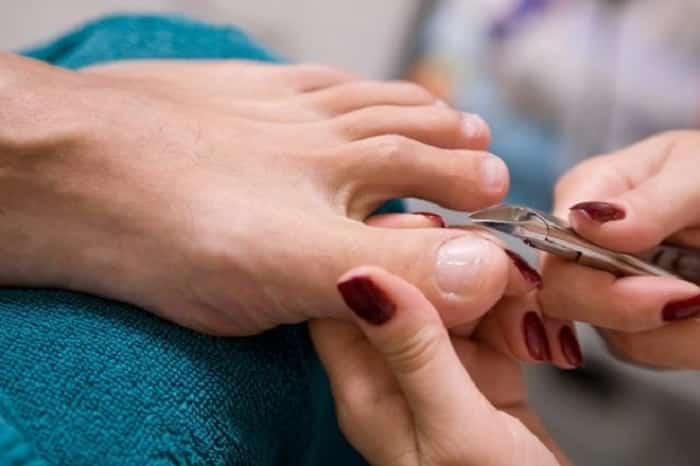
Professional pedicure for cracked nails
- foot condition
There are many diseases that also affect how often you need to get a pedicure. These are flat feet, congenital joint deformities, dermatological diseases with localized lesions on the legs.
The frequency of the procedure and compliance with all its stages guarantees not only an aesthetic appearance, but also healthy legs and nails.
Recommendations for creating

Yes, there are no clear requirements for the colors and design of nails for spring, but there are generally accepted, traditional options - we’ll talk about them.
- light shades . White, beige, pastel and nude tones symbolize lightness and freshness, so this is what you need for spring design;
- Blue-violet, lilac. Blue-violet, as the color of the year 2022, is relevant at any time of the year, including spring. It calms, pacifies, and is also suitable for women of any age and social status;
- colors of nature . Spring is the time when nature wakes up after winter sleep, so natural shades will be more relevant than ever. Pay attention to all shades of green, yellow, brown - with them you can create a spring pedicure even without additional design;
- lactic. Let us separately highlight milky gel polishes, which came into fashion at the end of 2022.
They will look harmonious with the colors listed above.:
- rhinestones. Stones are a familiar and almost universal move. You can highlight one nail, scatter it randomly or lay out a pattern;
- sparkles. Always appropriate and in any quantity;
- drawings. Flowers, ladybugs, and animal prints are chosen as designs for spring pedicure. In general, everything related to nature. Fans of complex designs can create an abstract pattern - this is also an excellent option for nail design in the spring.

